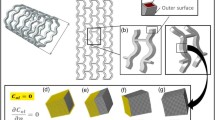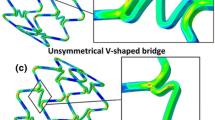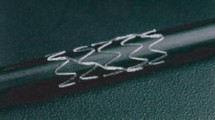Abstract
The field of percutaneous coronary intervention has witnessed many progressions over the last few decades, more recently with the advancement of fully degradable bioabsorbable stents. Bioabsorbable materials, such as metallic alloys and aliphatic polyesters, have the potential to yield stents which provide temporary support to the blood vessel and allow native healing of the tissue to occur. Many chemical and physical reactions are reported to play a part in the degradation of such bioabsorbable materials, including, but not limited to, corrosion mechanisms for metals and the hydrolysis and crystallization of the backbone chains in polymers. In the design and analysis of bioabsorbable stents it is important to consider the effect of each aspect of the degradation on the material’s in vivo performance. The development of robust computational modelling techniques which fully capture the degradation behaviour of these bioabsorbable materials is a key factor in the design of bioabsorable stents. A critical review of the current computational modelling techniques used in the design and analysis of these next generation devices is presented here, with the main accomplishments and limitations of each technique highlighted.






Similar content being viewed by others
References
Agrawal, C. M., K. F. Haas, D. A. Leopold, and H. G. Clark. Evaluation of poly(l-lactic acid) as a material for intravascular polymeric stents. Biomaterials 13:176–182, 1992.
Alexis, F. Factors affecting the degradation and drug-release mechanism of poly(lactic acid) and poly[(lactic acid)-co-(glycolic acid)]. Polym. Int. 54:36–46, 2005.
Alvarez-Lopez, M., M. D. Pereda, J. A. DelValle, M. Fernandez-Lorenzo, M. C. Garcia-Alonso, O. A. Ruano, and M. L. Escudero. Corrosion behaviour of AZ31 magnesium alloy with different grain sizes in simulated biological fluids. Acta Biomater. 6:1763–1771, 2010.
Arosio, P., V. Busini, G. Perale, D. Moscatelli, and M. Masi. A new model of resorbable device degradation and drug release—part I: zero order model. Polym. Int. 57:912–920, 2008.
Biotronik, A. G. Safety and clinical performance of the drug eluting absorbable metal scaffold (DREAMS 2nd Generation) in the treatment of subjects with de Novo lesions in native coronary arteries: BIOSOLVE-II. In: ClinicalTrials.gov. Bethesda, MD: National Library of Medicine (US), 2000. Accessed 2015 May 15. https://clinicaltrials.gov/ct2/show/NCT01960504.
Bobel, A. C., S. Petisco, J. Ramon Sarasua, W. Wenxin, and P. E. McHugh. Computational bench testing to evaluate the short-term mechanical performance of a polymeric stent. Cardiovasc. Eng. Technol., in press, 2015.
Chen, Y., Z. Xu, C. Smith, and J. Sankar. Recent advances on the development of magnesium alloys for biodegradable implants. Acta Biomater. 10:4561–4573, 2014.
Chen, Y., S. Zhou, and Q. Li. Mathematical modeling of degradation for bulk-erosive polymers: applications in tissue engineering scaffolds and drug delivery systems. Acta Biomater. 7:1140–1149, 2011.
Cheng, Y., S. Deng, P. Chen, and R. Ruan. Polylactic acid (PLA) synthesis and modifications: a review. Front. Chem. China 4:259–264, 2009.
Da Costa-Mattos, H. S., I. N. Bastos, and J. A. C. P. Gomes. A simple model for slow strain rate and constant load corrosion tests of austenitic stainless steel in acid aqueous solution containing sodium chloride. Corros. Sci. 50:2858–2866, 2008.
Durand, E., T. Sharkawi, G. Leclerc, M. Raveleau, M. van der Leest, M. Vert, and A. Lafont. Head-to-head comparison of a drug-free early programmed dismantling polylactic acid bioresorbable scaffold and a metallic stent in the porcine coronary artery: six-month angiography and optical coherence tomographic follow-up study. Circ. Cardiovasc. Interv. 7:70–79, 2014.
Farrar, D., and F. J. Buchanan. Chapter 9: modelling of the degradation processes for bioresorbable polymers. In: Degradation Rate of Bioresorbable Materials: Prediction and Evaluation, edited by D. Farrar. Amsterdam: Elsevier, 2008, pp. 183–206.
Ferdous, J., V. B. Kolachalama, and T. Shazly. Impact of polymer structure and composition on fully resorbable endovascular scaffold performance. Acta Biomater. 9:6052–6061, 2013.
Foin, N., R. D. Lee, R. Torii, J. L. Guitierrez-Chico, A. Mattesini, S. Nijjer, S. Sen, R. Petraco, J. E. Davies, C. Di Mario, M. Joner, R. Virmani, and P. Wong. Impact of stent strut design in metallic stents and biodegradable scaffolds. Int. J. Cardiol. 177:800–808, 2014.
Food and Drug Administration. ASTM-FDA Workshop on Absorbable Medical Devices:Lessons Learned from Correlations of Bench Testing and Clinical Performance. 2012. http://www.fda.gov/MedicalDevices/NewsEvents/WorkshopsConferences/ucm312601.htm.
Friedrich, H. E., and B. L. Mordike. Magnesium Technology. Berlin: Springer, 2006.
Fung, Y. C. Biomechanics: Mechanical Properties of Living Tissues. New York: Springer, 1981.
Gastaldi, D., V. Sassi, L. Petrini, M. Vedani, S. Trasatti, and F. Migliavacca. Continuum damage model for bioresorbable magnesium alloy devices: application to coronary stents. J. Mech. Behav. Biomed. Mater. 4:352–365, 2011.
Gogas, B. D., V. Farooq, Y. Onuma, and P. W. Serruys. The ABSORB bioresorbable vascular scaffold: an evolution or revolution in interventional cardiology. Hell. J Cardiol 53:301–309, 2012.
Gopferich, A. Mechanisms of polymer degradation and erosion. Biomaterials 17:103–114, 1996.
Grogan, J. A., D. Gastaldi, M. Castelletti, F. Migliavacca, G. Dubini, and P. E. McHugh. A novel flow chamber for biodegradable alloy assessment in physiologically realistic environments. Rev. Sci. Instrum. 84:094301, 2013.
Grogan, J. A., S. B. Leen, and P. E. McHugh. Optimizing the design of a bioabsorbable metal stent using computer simulation methods. Biomaterials 34:8049–8060, 2013.
Grogan, J. A., S. B. Leen, and P. E. McHugh. A physical corrosion model for bioabsorbable metal stents. Acta Biomater. 10:2313–2322, 2014.
Grogan, J. A., S. B. Leen, and P. E. McHugh. Computational micromechanics of bioabsorbable magnesium stents. J. Mech. Behav. Biomed. Mater. 34:93–105, 2014.
Grogan, J. A., B. J. O’Brien, S. B. Leen, and P. E. McHugh. A corrosion model for bioabsorbable metallic stents. Acta Biomater. 7:3523–3533, 2011.
Han, X., and J. Pan. A model for simultaneous crystallisation and biodegradation of biodegradable polymers. Biomaterials 30:423–430, 2009.
Haude, M., R. Erbel, P. Erne, S. Verheye, H. Degen, D. Böse, P. Vermeersch, I. Wijnbergen, N. Weissman, F. Prati, R. Waksman, and J. Koolen. Safety and performance of the drug-eluting absorbable metal scaffold (DREAMS) in patients with de-novo coronary lesions: 12 month results of the prospective, multicentre, first-in-man BIOSOLVE-I trial. Lancet 381:836–844, 2013.
Hayman, D., C. Bergerson, S. Miller, M. Moreno, and J. E. Moore. The effect of static and dynamic loading on degradation of PLLA stent fibers. J Biomech Eng 136:4027614, 2014.
Hermawan, H., D. Dubé, and D. Mantovani. Developments in metallic biodegradable stents. Acta Biomater. 6:1693–1697, 2010.
Khan, K. A., and T. El-Sayed. A phenomenological constitutive model for the nonlinear viscoelastic responses of biodegradable polymers. Acta Mech. 224:287–305, 2013.
Lin, Z., J. Luo, Z. Chen, J. Yi, H. Jiang, K. Tu, and L. Wang. A Monte Carlo simulation study of the effect of chain length on the hydrolysis of poly(lactic acid). Chin. J. Polym. Sci. 31:1554–1562, 2013.
Luo, Q., X. Liu, Z. Li, C. Huang, W. Zhang, J. Meng, Z. Chang, and Z. Hua. Degradation model of bioabsorbable cardiovascular stents. PLoS One 9:e110278, 2014.
Lyu, S., J. Schley, B. Loy, D. Lind, C. Hobot, R. Sparer, and D. Untereker. Kinetics and time–temperature equivalence of polymer degradation. Biomacromolecules 8:2301–2310, 2007.
Lyu, S., and D. Untereker. Degradability of polymers for implantable biomedical devices. Int. J. Mol. Sci. 10:4033–4065, 2009.
Mitra, A. K., and D. K. Agrawal. In stent restenosis: bane of the stent era. J. Clin. Pathol. 59:232–239, 2006.
Moore, Jr, J., J. Soares, and K. Rajagopal. Biodegradable stents: biomechanical modeling challenges and opportunities. Cardiovasc. Eng. Technol. 1:52–65, 2010.
Muliana, A., and K. R. Rajagopal. Modeling the response of nonlinear viscoelastic biodegradable polymeric stents. Int. J. Solids Struct. 49:989–1000, 2012.
Murphy, J. G., R. S. Schwartz, K. C. Huber, and D. R. Holmes, Jr. Polymeric stents: modern alchemy or the future? J. Invasive Cardiol. 3:144–148, 1991.
Okamura, T., P. W. Serruys, and E. Regar. Cardiovascular flashlight. The fate of bioresorbable struts located at a side branch ostium: serial three-dimensional optical coherence tomography assessment. Eur. Heart J. 31:2179, 2010.
Ong, A. T. L., E. P. McFadden, E. Regar, P. P. T. De Jaegere, R. T. Van Domburg, and P. W. Serruys. Late angiographic stent thrombosis (LAST) events with drug-eluting stents. J. Am. Coll. Cardiol. 45:2088–2092, 2005.
Ormiston, J. A., and P. W. S. Serruys. Bioabsorbable coronary stents. Circ. Cardiovasc. Interv. 2:255–260, 2009.
Ormiston, J. A., M. W. Webster, and G. Armstrong. First-in-human implantation of a fully bioabsorbable drug-eluting stent: the BVS poly-l-lactic acid everolimus-eluting coronary stent. Catheter Cardiovasc. Interv. 69:128–131, 2007.
Perale, G., P. Arosio, D. Moscatelli, V. Barri, M. Muller, S. Maccagnan, and M. Masi. A new model of resorbable device degradation and drug release: transient 1-dimension diffusional model. J. Control Release 136:196–205, 2009.
Peuster, M., C. Hesse, T. Schloo, C. Fink, P. Beerbaum, and C. von Schnakenburg. Long-term biocompatibility of a corrodible peripheral iron stent in the porcine descending aorta. Biomaterials 27:4955–4962, 2006.
Peuster, M., P. Wohlsein, M. Brügmann, M. Ehlerding, K. Seidler, C. Fink, H. Brauer, A. Fischer, and G. Hausdorf. A novel approach to temporary stenting: degradable cardiovascular stents produced from corrodible metal—results 6–18 months after implantation into New Zealand white rabbits. Heart 86:563–569, 2001.
Pidaparti, R. M., L. Fang, and M. J. Palakal. Computational simulation of multi-pit corrosion process in materials. Comput. Mater. Sci. 41:255–265, 2008.
Pitt, C. G., F. I. Chasalow, Y. M. Hibionada, D. M. Klimas, and A. Schindler. Aliphatic polyesters. I. The degradation of poly(ϵ-caprolactone) in vivo. J. Appl. Polym. Sci. 26:3779–3787, 1981.
Prabhu, S., and S. Hossainy. Modeling of degradation and drug release from a biodegradable stent coating. J. Biomed. Mater. Res. A 80:732–741, 2007.
Raabe, D., and R. C. Becker. Coupling of a crystal plasticity finite-element model with a probabilistic cellular automaton for simulating primary static recrystallization in aluminium. Model. Simul. Mater. Sci. Eng. 8:445–462, 2000.
Rajagopal, K. R., A. R. Srinivasa, and A. S. Wineman. On the shear and bending of a degrading polymer beam. Int. J. Plast. 23:1618–1636, 2007.
Rajagopal, K. R., and A. S. Wineman. A constitutive equation for nonlinear solids which undergo deformation induced microstructural changes. Int. J. Plast. 8:385–395, 1992.
Schaffer, J. E., E. A. Nauman, and L. A. Stanciu. Cold drawn bioabsorbable ferrous and ferrous composite wires: an evaluation of in vitro vascular cytocompatibility. Acta Biomater. 9:8574–8584, 2013.
Shazly, T., V. B. Kolachalama, J. Ferdous, J. P. Oberhauser, S. Hossainy, and E. R. Edelman. Assessment of material by-product fate from bioresorbable vascular scaffolds. Ann. Biomed. Eng. 40:955–965, 2012.
Shirazi, R. N., F. Aldabbagh, A. Erxleben, Y. Rochev, and P. McHugh. Nanomechanical properties of poly(lactic-co-glycolic) acid film during degradation. Acta Biomater. 10:4695–4703, 2014.
Soares, J. S. Constitutive Modeling for Biodegradable Polymers for Application in Endovascular Stents. Doctoral dissertation, Texas A&M University, 2008.
Soares, J. S., J. E. Moore, Jr, and K. R. Rajagopal. Constitutive framework for biodegradable polymers with applications to biodegradable stents. ASAIO J. 54:295–301, 2008.
Soares, J. S., J. E. Moore, and K. R. Rajagopal. Modeling of deformation-accelerated breakdown of polylactic acid biodegradable stents. J. Med. Device. 4:41007, 2010.
Soares, J., K. Rajagopal, and J. Moore Jr. Theoretical modeling of cyclically loaded, biodegradable cylinders. In: 3rd European Conference on Computational Mechanics, edited by C. A. Motasoares, J. A. C. Martins, H. C. Rodrigues, J. C. Ambrósio, C. A. B. Pina, C. M. Motasoares, E. B. R. Pereira, and J. Folgado. Netherlands: Springer, 2006, p. 207. doi:10.1007/1-4020-5370-3_207.
Soares, J. S., K. R. Rajagopal, and J. E. Moore, Jr. Deformation-induced hydrolysis of a degradable polymeric cylindrical annulus. Biomech. Model. Mechanobiol. 9:177–186, 2010.
Song, G., and A. Atrens. Corrosion mechanisms of magnesium alloys. Adv. Eng. Mater. 1:11–33, 1999.
Sweeney, C. A., P. E. McHugh, J. P. McGarry, and S. B. Leen. Micromechanical methodology for fatigue in cardiovascular stents. Int. J. Fatigue 44:202–216, 2012.
Tamai, H., K. Igaki, E. Kyo, K. Kosuga, A. Kawashima, S. Matsui, H. Komori, T. Tsuji, S. Motohara, and H. Uehata. Initial and 6-month results of biodegradable poly-l-lactic acid coronary stents in humans. Circulation 102:399–404, 2000.
Tormala, P., T. Pohjonen, and P. Rokkanen. Bioabsorbable polymers: materials technology and surgical applications. Proc. Inst. Mech. Eng. H 212:101–111, 1998.
Verheye, S., M. Webster, J. Stewart, A. Abizaid, R. Costa, J. Costa, J. Yan, V. Bhat, L. Morrison, S. Toyloy, and J. Ormiston. TCT-563 multi-center, first-in-man evaluation of the myolimus-eluting bioresorbable coronary scaffold: 6-month clinical and imaging results. J. Am. Coll. Cardiol. 60:B163, 2012.
Waksman, R. Absorbable Metal Stent, Clinical Update and DREAMS: Concept and Preclinical Data. Tel-Aviv: Innovations of Cardiovascular Interventions, 2007.
Waksman, R., R. Erbel, C. Di Mario, J. Bartunek, B. de Bruyne, F. R. Eberli, P. Erne, M. Haude, M. Horrigan, C. Ilsley, D. Böse, H. Bonnier, J. Koolen, T. F. Lüscher, and N. J. Weissman. Early- and long-term intravascular ultrasound and angiographic findings after bioabsorbable magnesium stent implantation in human coronary arteries. JACC Cardiovasc. Interv. 2:312–320, 2009.
Waksman, R., R. Pakala, R. Baffour, R. Seabron, D. Hellinga, and F. O. Tio. Short-term effects of biocorrodible iron stents in porcine coronary arteries. J. Interv. Cardiol. 21:15–20, 2008.
Wang, Y., J. Pan, X. Han, C. Sinka, and L. Ding. A phenomenological model for the degradation of biodegradable polymers. Biomaterials 29:3393–3401, 2008.
Weir, N. A., F. J. Buchanan, J. F. Orr, and G. R. Dickson. Degradation of poly-l-lactide. Part 1: in vitro and in vivo physiological temperature degradation. Proc. Inst. Mech. Eng. H 218:307–319, 2004.
Witte, F., J. Fischer, J. Nellesen, H. A. Crostack, V. Kaese, A. Pisch, F. Beckmann, and H. Windhagen. In vitro and in vivo corrosion measurements of magnesium alloys. Biomaterials 27:1013–1018, 2006.
Wu, W., S. Chen, D. Gastaldi, L. Petrini, D. Mantovani, K. Yang, L. Tan, and F. Migliavacca. Experimental data confirm numerical modeling of the degradation process of magnesium alloys stents. Acta Biomater. 9:8730–8739, 2013.
Wu, W., D. Gastaldi, K. Yang, L. Tan, L. Petrini, and F. Migliavacca. Finite element analyses for design evaluation of biodegradable magnesium alloy stents in arterial vessels. Mater. Sci. Eng. B Solid-State Mater. Adv. Technol. 176:1733–1740, 2011.
Wu, W., L. Petrini, D. Gastaldi, T. Villa, M. Vedani, E. Lesma, B. Previtali, and F. Migliavacca. Finite element shape optimization for biodegradable magnesium alloy stents. Ann. Biomed. Eng. 38:2829–2840, 2010.
Zartner, P., R. Cesnjevar, H. Singer, and M. Weyand. First successful implantation of a biodegradable metal stent into the left pulmonary artery of a preterm baby. Catheter. Cardiovasc. Interv. 66:590–594, 2005.
Zheng, Y. F., X. N. Gu, and F. Witte. Biodegradable metals. Mater. Sci. Eng. R Reports 77:1–34, 2014.
Acknowledgments
The authors wish to acknowledge funding from the Irish Research Council for Science, Engineering and Technology and a Postgraduate Research Fellowship from the College of Engineering and Informatics, NUI Galway.
Author information
Authors and Affiliations
Corresponding author
Additional information
Associate Editor Sean McGinty oversaw the review of this article.
Enda L. Boland and Connor J. Shine contributed equally to the article.
Rights and permissions
About this article
Cite this article
Boland, E.L., Shine, C.J., Kelly, N. et al. A Review of Material Degradation Modelling for the Analysis and Design of Bioabsorbable Stents. Ann Biomed Eng 44, 341–356 (2016). https://doi.org/10.1007/s10439-015-1413-5
Received:
Accepted:
Published:
Issue Date:
DOI: https://doi.org/10.1007/s10439-015-1413-5




